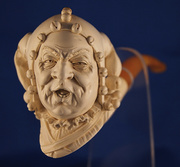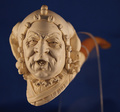
Fire, as everyone in the Western world knows, was bestowed upon humankind by the Greek Titan Prometheus, who stole it from the god of thunderbolts and lightning, the very, very frightening Zeus. Subsequently, throughout most of recorded history—and presumably everything that came before—people organized their lives around their ability to rekindle a flickering flame, lest they suffer from cold in the winter or the digestive distress of eating too much raw meat.
Author and collector Ian Spellerberg’s interest in fire is somewhat less encompassing, limited to match holders, matchsafes, and vesta cases made in England and her colonies between the years 1830 and 1920. Those years coincide roughly with the date of the invention of the friction match in 1826 and the ubiquity of safety matches, cheap matchbooks, and cigarette lighters after World War I, all of which depressed the demand for devices designed to hold volatile sulfur- or phosphorus-tipped sticks.

Top: In this humorous ceramic figurine, a kitten suggests that users should strike their matches on its mother’s rump. Above: The Lovett Tinder Box was introduced in 1899. It sold for a shilling, mostly in South Africa.
If Spellerberg’s quest for fire is narrow compared to the element’s post-Promethean history, his passion for the topic burns no less bright, as seen in the entertaining and informative 2016 book he edited called Match Holders: First-hand Accounts of Tinderboxes, Matches, Spills, Vesta Cases, Match Strikers, and Permanent Matches. Comprised of photographs taken by Spellerberg and diary entries written by his late match-holder mentor, John McLean, Match Holders is a uniquely personal history of yet another class of objects that the world once considered indispensable but has somehow managed to live without.

This small (under 4 inches tall) spill vase held splints for transferring a burning flame from, say, a fireplace or stove to a candle.
“Ceramic match holders enjoyed wide appeal because their designs tended to be in harmony with the rest of a home’s furnishings.”
Match Holders begins with a chapter on tinderboxes, which were a popular form of portable fire-making prior to the invention of the friction match by an English pharmacist named John Walker. Tinderboxes consisted of three basic ingredients—a piece of steel, often called “fire steel”; a stone flint; and tinder, usually some dried fungi or charred linen. “With practice and patience,” McLean writes, “sparks could indeed be produced by striking the steel against the stone flint. If a spark landed in the dry tinder, care was needed to coax the spark into a smouldering piece of tinder then a flame.” As McLean recounts, the clink, clink, clink of steel coming in contact with stone was once a common early morning sound, as must also have been the curses that bounced off the rafters when cold, numb hands caused a hard chunk of steel to miss its mark. Little wonder, McLean writes, “that some domestic fires were kept permanently alight.”
To that end, many homes were dotted with decorative containers known as “spill vases” to hold slender pieces of wood called spills, splints, tapers, or splunks. These were used to transfer a flame from that permanently burning domestic fire to the candles that illuminated one’s abode. “Spills,” McLean writes in his diary, “were in use long after tinderboxes had largely been replaced by match holders.” But because matches were more valuable than spills, he writes, the use of spills to transfer flames was preferable to burning, and thus wasting, a perfectly good match.

Victorian artisans were enthralled with the natural world, so little wonder that natural materials such as (clockwise from top left) snakeskin, ivory, leather, horn, shell, and tooth were used to construct match holders.
Equally decorative were match holders, which were made of pretty much anything artisans could get their hands on. Precious metals such as silver and gold were obvious choices, as were brass, copper, and tin, the latter being mostly produced by match manufacturers or the thrifty—as Spellerberg explained in an email, “One of earliest forms of upcycling came in the form of small tins (for cocoa or razor blades) that had strikers or scratchers on them. Once the contents were used, the container made an excellent matchbox.”
In Match Holders, McLean seems especially taken with containers made from natural materials such as snakeskin, ivory, leather, tooth, shell, and horn—helpfully, Spellerberg gathered a collection of these very items together for a group photograph.

The match holder and striker on the left was made by John McLean, whose diaries are the subject of Ian Spellerberg’s new book. The comic postcard at right merely offered a surface to strike.
Pieces like these were likely made by jewelers or skilled artisans, but just as many match holders were fashioned out of more common materials such as felt and sandpaper by the people who used them. Also at the inexpensive end of the spectrum are comic postcards that offered users a surface to strike, the placement of which no doubt prompted Edwardian titters. A parallel trend of the early 20th century was the comic figurine, whose dimensionality provided places for matches, both struck and unstruck, as well as a rough surface to set them alight.

Three examples of ceramic match holders by (clockwise from top) Royal Doulton, Gouda, and Torquay potteries.
Figurines were one form of ceramic match holder; small receptacles or vases were another. The venerable English pottery Royal Doulton made all manner of these sorts of holders, including one designed for a quartet of friends getting together for an evening of cards. This particular match holder featured two receptacles for matches plus four matching ashtrays, each bearing a spade, club, heart, or diamond. Other potteries known for their match holders were Carlton, Torquay, and Gouda.

This novelty item from the 1880s held matches in its barrel and featured a depression in the top for trimming one’s cigar.
Ceramic match holders enjoyed wide appeal because their designs tended to be in harmony with the rest of a home’s furnishings. In contrast, novelty vesta cases were less concerned about fitting in, as in the late 1880s pistol built for one handgun-happy cigar smoker. The pistol was nothing if not versatile, offering its owner two striking surfaces on the underside of its barrel—one for friction matches and another for safety matches—as well as a cigar cutter, which was operated by inserting the tip of a cigar into a depression in the top of the faux weapon, and then pulling the device’s trigger. Matches were stored in the barrel.

A Louis Vuitton match holder reveals how these utilitarian accessories were elevated to the realm of luxury goods.
An object as multipurpose as that seems a long way away from a modest, utilitarian spill vase. It’s also fairly far removed from the match holders produced by such luxury-goods manufacturers as Tiffany & Co., Liberty, Hermes, and Louis Vuitton. Then again, who says fire can’t be fashionable?
(In 2017, “Match Holders: First-hand Accounts of Tinderboxes, Matches, Spills, Vesta Cases, Match Strikers, and Permanent Matches” received the K.C. Literary Award from the British Matchbox Label and Bookmatch Society.)

 Gloriously Grotesque 19th-Century Pipes
Gloriously Grotesque 19th-Century Pipes
 Playing With Matches: Sexy, Silly 1930s Ads That Went Up in Smoke
Playing With Matches: Sexy, Silly 1930s Ads That Went Up in Smoke Gloriously Grotesque 19th-Century Pipes
Gloriously Grotesque 19th-Century Pipes When the World Truly Stank, Tussie-Mussies Were a Breath of Fresh Air
When the World Truly Stank, Tussie-Mussies Were a Breath of Fresh Air Match HoldersMatch holders, also known as matchsafes or vesta cases, date to the mid-19t…
Match HoldersMatch holders, also known as matchsafes or vesta cases, date to the mid-19t… TobaccianaTobacco became popular in Europe in the 1600's, after traders brought back …
TobaccianaTobacco became popular in Europe in the 1600's, after traders brought back … Mari Tepper: Laying it on the Line
Mari Tepper: Laying it on the Line Nice Ice: Valerie Hammond on the Genteel Charm of Vintage Canadian Costume Jewelry
Nice Ice: Valerie Hammond on the Genteel Charm of Vintage Canadian Costume Jewelry How Jim Heimann Got Crazy for California Architecture
How Jim Heimann Got Crazy for California Architecture Modernist Man: Jock Peters May Be the Most Influential Architect You've Never Heard Of
Modernist Man: Jock Peters May Be the Most Influential Architect You've Never Heard Of Meet Cute: Were Kokeshi Dolls the Models for Hello Kitty, Pokemon, and Be@rbrick?
Meet Cute: Were Kokeshi Dolls the Models for Hello Kitty, Pokemon, and Be@rbrick? When the King of Comedy Posters Set His Surreal Sights on the World of Rock 'n' Roll
When the King of Comedy Posters Set His Surreal Sights on the World of Rock 'n' Roll How One Artist Makes New Art From Old Coloring Books and Found Photos
How One Artist Makes New Art From Old Coloring Books and Found Photos Say Cheese! How Bad Photography Has Changed Our Definition of Good Pictures
Say Cheese! How Bad Photography Has Changed Our Definition of Good Pictures Middle Earthenware: One Family's Quest to Reclaim Its Place in British Pottery History
Middle Earthenware: One Family's Quest to Reclaim Its Place in British Pottery History Fancy Fowl: How an Evil Sea Captain and a Beloved Queen Made the World Crave KFC
Fancy Fowl: How an Evil Sea Captain and a Beloved Queen Made the World Crave KFC
Rural Midwest, Us, schoolboys made match holders by splitting old tobacco cans horizontally, shortening them, and then fitting them back together.
I’d like an example of British Shorthair cats
The one my friend has is covered in fabric with a beaded floral pattern and the year “1910” beaded at the bottom. I have seen others with a date like this, too. Why were they dated? How often were they replaced? Would this fancy version have been hung by a living room fireplace rather than in a kitchen? And I can’t seem to find a place for striking the match.